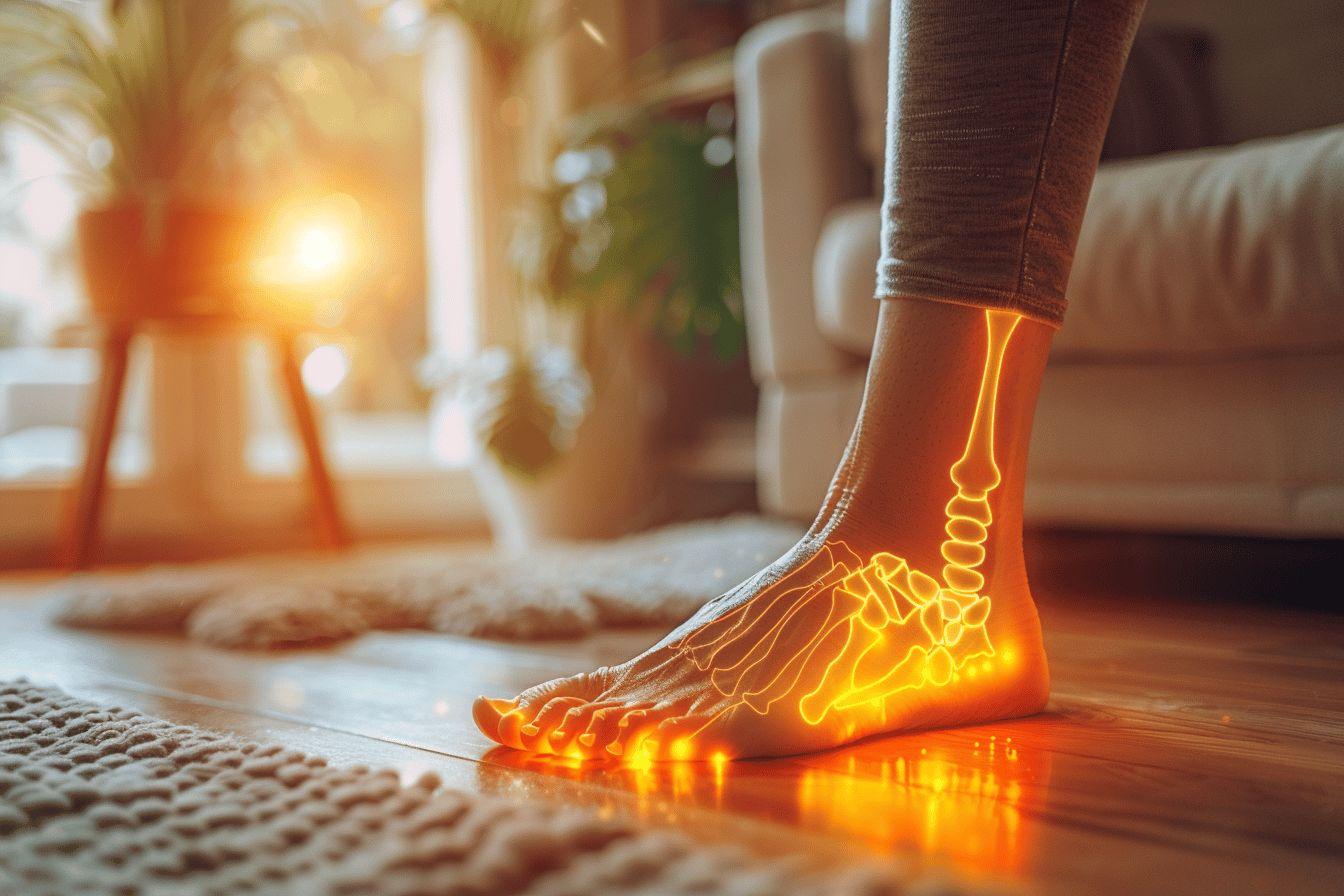Article at a glance
Pain in the soles of the feet can have a variety of causes, requiring a precise diagnosis for appropriate treatment.
- Plantar fasciitis is the most common cause, causing intense heel pain, especially in the morning.
- Heel spurs are bony growths that create localized painful sensations that intensify when walking.
- Other causes include Morton's neuromas, metatarsalgia, stress fractures, and tendonitis.
- Aggravating factors such as being overweight, high-impact sports, and unsuitable footwear increase the risks.
Experiencing pain in the soles of the feet can make every step a real ordeal. These unpleasant, sometimes even debilitating, sensations affect many people, regardless of their age or activity level. Understanding the origin of this pain is the first step toward effective and lasting relief.
The Main Causes of Plantar Pain
Pain felt in the soles of the feet can come from a variety of sources. Identifying the precise cause allows for the most appropriate treatment. Chronic or acute plantar pain should never be ignored as it can signal more serious problems.
Plantar fasciitis is one of the most common causes. This inflammation affects the plantar fascia, a band of fibrous tissue that connects the heel to the toes. People suffering from this condition typically experience intense heel pain, especially during their first steps in the morning. causes of pain under the feet often include this condition, which frequently affects athletes and people who stand for long periods.
Heel spurs are another major source of pain. These are bony growths that form on the calcaneus (heel bone). These spurs cause localized painful sensations that intensify when walking or running.
Other common causes include:
- Interdigital neuritis (Morton's neuroma)
- Metatarsalgia (pain in the forefoot)
- Metatarsal stress fractures
- Arthritis and osteoarthritis of the foot joints
- Various tendonitis (Achilles tendon, posterior tibial)
Systemic diseases such as diabetes or rheumatoid arthritis can also cause plantar pain due to nerve or joint damage. In the case of diabetes, peripheral neuropathy often causes burning or tingling sensations under the feet.

Aggravating factors and at-risk populations
Certain factors significantly increase the risk of developing plantar pain. Being overweight places excessive pressure on the arch of the foot, putting additional strain on the structures of the foot. Intensive practice of high-impact sports such as running, basketball, or tennis also increases microtraumas to the plantar fascia.
Wearing unsuitable footwear is an often underestimated factor. Shoes that are too flat, without arch support, or conversely, heels that are too high, alter body weight distribution and create abnormal pressure points.
Anatomical abnormalities also play a determining role. Flat feet, or conversely, highly arched feet, predispose to plantar pain by altering the normal biomechanics of the foot when walking.
| Risk Factor | Impact on the soles of the feet | Population concerned |
|---|---|---|
| Overweight/Obesity | Increased plantar pressure | Adults with high BMI |
| Impact sports | Repetitive microtrauma | Athletes, runners |
| Unsuitable shoes | Poor distribution of pressure | Women wearing high heels, people with worn shoes |
| Anatomical abnormalities | Altered biomechanics | People with flat or high-arched feet |
People who work in occupations requiring them to stand for long periods are particularly vulnerable. Salespeople, hairdressers, healthcare workers, and waiters put intense strain on their feet during their workday.
Effective solutions for relieving plantar pain
When dealing with plantar pain, several therapeutic approaches can be implemented. Rest is often the first step, particularly in cases of acute pain. Limiting activities that exacerbate pain allows inflamed tissues to recover.
Applying ice several times a day helps reduce inflammation and alleviate pain. This simple but effective method can be complemented with specific plantar fascia and calf stretches to improve tissue flexibility.
Orthopedic insoles or foot orthotics are a particularly effective solution. They support the arch of the foot and better distribute pressure across the foot. These devices can be prefabricated or custom-made by a podiatrist depending on the specifics of your problem.
Here are the most commonly recommended treatment approaches, listed in order of intervention:
- Rest and modification of painful activities
- Icing and self-massage techniques
- Targeted stretching and muscle strengthening
- Wearing appropriate orthopedic insoles
- Anti-inflammatory drug treatments
In some cases, effective techniques to quickly relieve foot pain may be necessary before starting long-term treatment. Corticosteroid injections may be offered for severe and persistent pain, but should be used only occasionally.
Physical therapy also plays an important role in treatment. The physiotherapist can offer manual joint mobilization techniques and personalized exercise protocols aimed at restoring normal foot function.
When to consult a healthcare professional?
If plantar pain persists despite self-treatment measures, a medical consultation is necessary. Certain warning signs should be present and prompt treatment: intense pain that limits daily activities, significant swelling, redness, or warmth in the foot that may suggest infection.
People with diabetes should be particularly vigilant. Any injury or unusual pain in the feet requires immediate medical attention due to the specific risks associated with this condition.
Depending on the nature of the problem, different professionals may be involved. The general practitioner may refer the patient to a podiatrist, rheumatologist, or orthopedic surgeon depending on the complexity of the case. Medical imaging (X-ray, ultrasound, MRI) may be prescribed to refine the diagnosis and guide treatment.
Prevention remains essential to avoid the recurrence of plantar pain. Choosing shoes that are adapted to your body shape and activity, maintaining a healthy weight, and practicing regular stretching are the pillars of good podiatric health. For athletes, gradually increasing the intensity of training and alternating activities limits the risk of overuse injuries.





Leave a comment
This site is protected by hCaptcha and the hCaptcha Privacy Policy and Terms of Service apply.